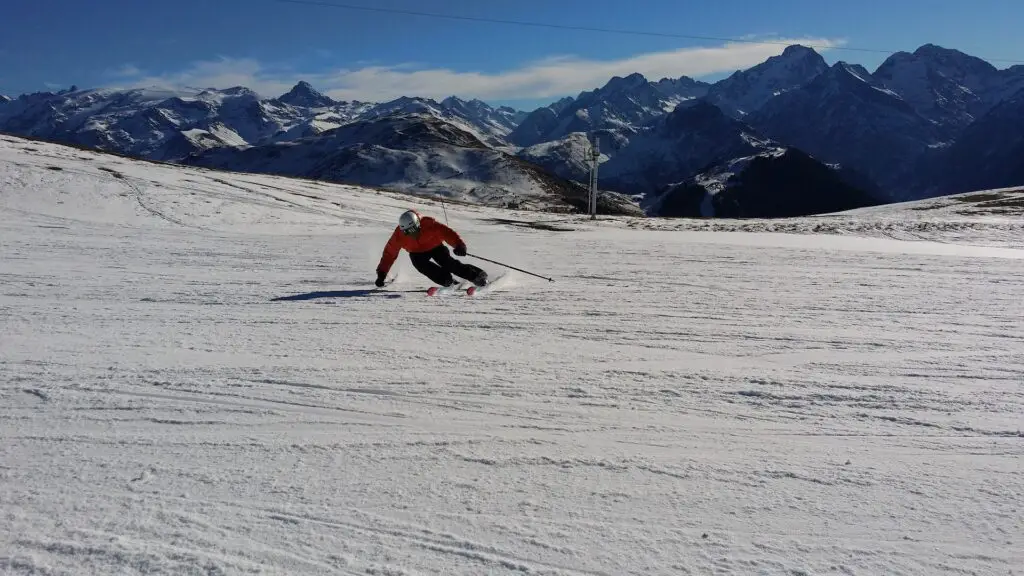Whether you are completely new to skiing or developing your technique, you might wonder what type of skis you will need to buy or rent. There are a wide variety of skis available which range in length and flex, along with the type of skiing they are designed for.
Lots of people come across skis designed for different abilities, such as beginner, intermediate and advanced skis. This leads many people to wonder if there really is a difference between them and why they might be better suited to different abilities.
Getting the right pair of skis is essential to improving your technique and getting as much out of your ski trip as possible! Therefore, it is important to first know what skiing ability you are, what skis might be best to suit your ability and how certain features of skis might differ as you improve.
If you would like to know the main differences between beginner and advanced skis, keep reading for the ultimate guide on skis for different skiing abilities!
At a Glance
Beginner skis are typically shorter, more flexible and with a thinner waist width than advanced skis. Beginner skis are designed for easier slopes, easy terrains and to travel at slower speeds than advanced skis.
Are you a Beginner or Advanced Skier?
The first thing to consider when looking for a pair of skis is what level of skiing you are at. While there are no strict rules of when a skier becomes intermediate or advanced, there are normally some key differences in ability, technique and the type of skiing you might be attempting.
Beginner Skiers
Beginner skiers are just as the name suggests. This normally means that you have not been skiing for a long time and are still working on the basics and improving your technique.
This also means that you should be attempting easier slopes with shallower gradients. These will be easier for you to practice technique on without picking up too much speed and potentially losing control. This will mean that you can learn to control your speed and stop safely before trying out steeper slopes.
This will also mean you will generally be travelling at slower speeds compared to some intermediate or advanced skiers, and in general applying less pressure to the front of your boots and on your skis.
If you are a beginner skier, you will also likely only be skiing on pistes where piste bashers are used. These will have been flattened and smoothed by piste bashers, making them easier to ski on. This means you are unlikely to be travelling through deep snow or face sudden changes in terrain.
Advanced Skiers
Advanced skiers typically have developed their technique and are comfortable carving. This means that they will generally have more precise control over your skis and be able to tackle tougher slopes.
Advanced skiers may attempt steeper slopes, meaning that they will likely be travelling at higher speeds and putting more pressure on the front of their boots and on their skis. This requires skis that are able to cope with this pressure and also give the skier precise carving control.
However, not all advanced skiers want to travel at higher speeds or simply down steeper slopes. Some may wish to improve their skills off-piste or going over jumps if they are sufficiently trained and able to do so. Different activities might therefore need skis with different qualities.
Some skiers who are more advanced may also attempt different terrains. This could be mogul runs, off-piste runs and areas with powder. Advanced skiers may also want to ski on simple pistes as well, so may need skis which can perform well in mixed terrains, or have different skis for different terrains.
| Beginner | Advanced | |
| Gradient | Shallower slopes Nursery and green slopes | Steeper slopes Most colour categories of slopes |
| Speed | Generally slow speeds | Can maintain control at higher speeds |
| Terrain | Smooth pistes | Smooth pistes Possibly moguls Possibly off-piste and powder terrain |
What differs between skis at different levels?
A number of features can differ between beginner and advanced skis. A few of them are listed below.
It is important to remember that not all beginner and not all advanced skiers are the same. Some may be attempting different types of slopes, so which this is a very general guide, it is important to think about your precise level and what skiing you will be doing to get the right skis for you. Ask in stores or ski rentals for more advice on the skis you should get.
- Length
- Flex
- Waist width
| Ability | Ski Length | Flex | Waist Width |
| Beginner | slightly shorter | more flex | thinner |
| Advanced | slightly longer | stiffer | thicker |
Ski Length
Ski length is mostly determined by your height to make sure that you are able to easily manage and control them out on the piste. Therefore, the ski length can vary significantly between people.
However, you can still get skis of slightly different lengths depending on your ability, which can affect your technique and your ability to improve this.
Beginner Skiers
Beginners usually ski on slightly shorter skis than advanced skiers. This is because shorter skis are easier to turn and control when travelling at slower speeds. This is necessary for beginner skiers in particular, who will likely be attempting less steep slopes while learning and improving their technique. This will also mean that they are unlikely to be skiing quickly, and will be keeping to slower speeds to ensure they are in control.
Advanced Skiers
Advanced skiers may have slightly longer skis. These may be slightly harder to control and turn at slow speeds for less experienced skiers. However, advanced skiers are often able to easily control longer skis when travelling at slow speeds due to their advanced technique. Longer skis are also more suitable to travelling and carving at higher speeds.
Flex
Ski flex is simply an index of how flexible your skis are and how much they are able to bend as pressure is applied to them.
Beginner Skiers
Beginner skis typically are more flexible than the stiffer, more advanced skis. More flexible skis are much more forgiving to small mistakes in technique, meaning beginners can keep control over their skis despite not having perfect technique.
Advanced Skiers
Advanced skis tend to be slightly less flexible than beginner skis. This allows more pressure to be applied to them as skiers may travel slightly faster and on steeper, more challenging slopes.
Check out this complete guide to ski stiffness ratings to learn more about this topic.

Waist Width
Waist width of skis described the width in millimetres (mm) at the thinnest part of the ski (the waist), which is usually found directly beneath the foot. This width can vary between different skis and narrower or wider ski waist width can be better suited to different types of skiers.
Beginner Skiers
Beginner skis usually have slightly narrower waist width compared to skis designed for advanced skiers. This is because beginner skiers are likely to be travelling on less steep slopes at a slower speed. Narrower waist width may be easier to turn at slower speeds, making them easier for beginners to control.
Beginner skiers are also likely to be skiing on pistes where piste bashers ensure they are generally smooth. Skis with narrow waist width are suited to this type of skiing, whereas skis with wider waist widths may be better suited to variable terrains or powder skiing which may not be necessary for beginner skiers.
Check out this article on the best ski waist width for beginners to learn more.
Advanced Skiers
Advanced skis tend to have slightly wider ski waist widths compared to beginner skis. However, these do not have to be as wide as skis that are designed for powder which some advanced skiers may attempt.
Skis designed for skiing in powder snow often have the widest waist width. This allows skis to cope better skiing in deep snow as they are able to glide over it without sinking too deep and causing the skier to lose control. However, not all advanced skis necessarily need to be this wide.
Skis with slightly wider waist width are often able to handle different terrains easier, such as off-piste or some powder. Advanced skis may therefore have intermediate waist widths, meaning they are able to cope with more challenging terrain, while not compromising their performance on pistes.
To Conclude
Beginner and advanced skis vary in a variety of factors. Beginner skis tend to be shorter and more flexible, with narrower waist width to ensure control at slower speeds. More advanced skis tend to be longer and allow more precise turning and may also be suitable for a variety of terrains.
However, many features of your skis is personal preference and trying out and getting advice in store on different skis can be a good way to make sure you have skis that are perfect for you.
Here are some more articles you might find useful:
